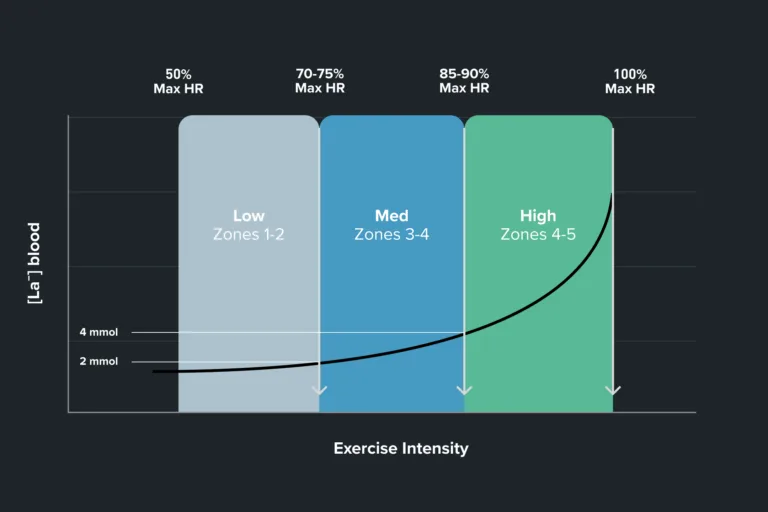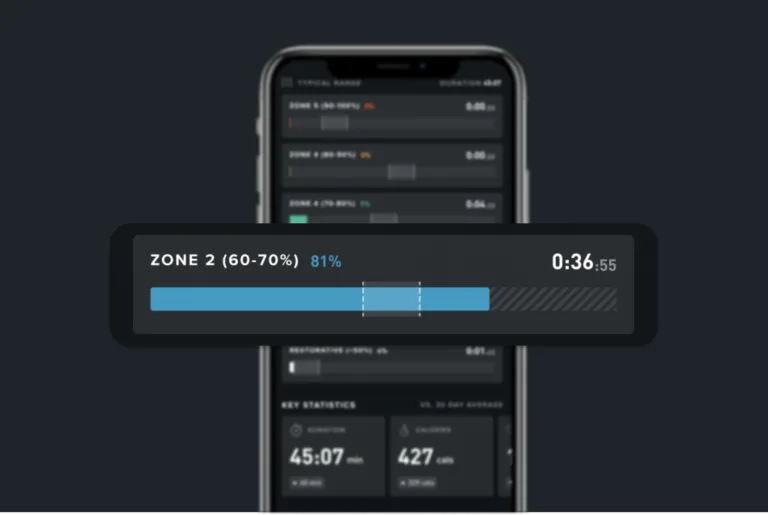Topics
- Article
- Training & Exercise
Why Zone 2 Training is the Secret to Unlocking Peak Performance

For years, high intensity workouts were the norm for anyone looking to improve their overall fitness and see performance gains. The sweatier, the more intense, and the more demanding, the better the workout was perceived to be. However, research has shown that Zone 2 training, meaning training done at 60-70% of your max heart, allows you to build an aerobic base, enhancing your endurance, optimizing your fitness, and unlocking performance gains. While it is often overlooked as a modality of training best for endurance athletes, Zone 2 has enormous benefits for anyone, regardless of their fitness level or goals.
Zone 2 training focuses on working out a moderate intensity level, based on your individual rate of perceived exertion (RPE). Because everyone is different, the best gauge to understand if you’re in the proper zone is to measure 60-70% of your max heart rate. Training in this zone makes oxygen the primary driver of energy production, in turn increasing aerobic capacity.
Whether you are interested in optimizing your exercise performance, improving body composition, avoiding injury and overtraining, or improving longevity and preventing disease, Zone 2 heart rate training deserves your attention.
How does WHOOP measure heart rate zones?
Strain is a function of your max heart rate and the amount of time you spend in different heart rate zones, the more time spent in elevated heart rates, the higher your Strain. WHOOP uses the heart rate reserve method, which takes into account your max heart rate and resting heart rate over the last 14 recoveries to give you more accurate and personalized HR zones, so as you make progress your HR zones will reflect that.
WHAT IS ZONE 2 TRAINING?
Zone 2 training, often referred to as aerobic training, is characterized by a low-to-moderate level of cardiovascular exertion and power output that can be maintained for a substantial amount of time.
Think of an ‘easy run’ or a moderate bike ride. During this type of training, the body has enough time to synthesize sufficient amounts of energy to keep up the given level of effort that muscles are demanding without inducing too much fatigue. Defining this zone by heart rate (HR) is difficult given it’s highly individual, but getting to 60-75% of your max heart rate, or a 5-6 out of 10 effort, is a good approximation.
HOW DOES WHOOP DEFINE ZONE 2?
WHOOP defines Zone 2 as 60-70% of your realized maximum heart rate, or the maximum heart rate that you have logged using WHOOP. This range ensures that you remain at the correct metabolic and effort level to gain near-maximum adaptation while mitigating fatigue that could hurt future performance.
WHY IS ZONE 2 TRAINING IMPORTANT?
Zone 2 training is essential for aerobic development, but it also helps you improve your body’s energy efficiency, prevent injury, improve recovery, and weight management. While it is often utilized by endurance athletes, Zone 2 has benefits for anyone, regardless of their fitness level or goals.
Zone 2 exercise enhances our body’s ability to produce energy over time.
Zone 2 exercise enhances our body’s ability to produce energy over time. The main energy production sites within cells – mitochondria – multiply when the energy needs of a cell increase. Healthier mitochondria mean a healthier and better performing body.
Think of your mitochondria like a muscle that can be trained. When you’re trying to build muscle, you continuously stimulate them with high quality effort. If you use too much weight or perform too many reps, you may get injured or be too fatigued to train the next day. Zone 2 trains your mitochondrial system to more effectively serve your body just like your muscles, over time actually increasing the number of mitochondria you have and their efficiency.
Zone 2 training decreases the risk of health conditions.
At low intensities, like Zone 2, mitochondria produce energy through the oxidation of free fatty acids. At higher intensities, mitochondria produce energy through the oxidation of carbohydrates (glucose). Zone 2 trains our mitochondria by producing energy entirely using fatty acids, building our mitochondria from the ground up. People who are poorly trained or metabolically unhealthy struggle with using fatty acids for energy – instead, their mitochondria instantly use glucose as a fuel source even for low intensity activity or rest. This leads to mitochondrial dysfunction, a hallmark of diseases like type 2 diabetes, cancer, heart disease, and more.
Zone 2 training helps you avoid acute fatigue.
We can prevent these negative impacts by training our mitochondria to use all fuel sources more efficiently. When performing Zone 2 exercise, the body burns through fatty acids in the mitochondria to generate output over long periods – a slower, more stable energy burn that allows you to avoid acute fatigue and continue to exercise for long durations. This means that your body will be able to produce both fast (glucose) and slow (fat) energy to improve your immune function, cognitive performance, longevity, and more.
Zone 2 training improves HRV and RHR.
Zone 2 exercise also improves key health metrics like heart rate variability (HRV) and resting heart rate (RHR). It increases HRV over time by decreasing the sympathetic response, and increases parasympathetic activation. Zone 2 can also improve your resting heart rate by enhancing blood flow and function of the heart through continuous contraction of the heart for long durations.
Zone 2 training can improve sleep.
Zone 2 can also help improve sleep, especially in the context of other high-intensity training. During high training load blocks, individuals exhibit decreased sleep quantity, quality, and disturbance, as well as increased sleep latency. Studies have also shown that REM sleep meaningfully decreases during blocks of high intensity training. Because Zone 2 can improve recovery ability, it may help improve sleep.
WHY DOES ZONE 2 MATTER FOR TRAINING AND EXERCISE PERFORMANCE?
Zone 2 training improves the body’s aerobic energy system, enhancing your ability to fight fatigue. When you exercise at a high intensity, your body’s demand for energy surpasses what the aerobic system can provide. This kicks off the production of lactate, a byproduct of high-intensity energy production. When this process begins, it’s referred to as the crossover point between aerobic training and anaerobic training.

To improve your performance, the goal is to stave off the accumulation of lactate. Stronger and more plentiful mitochondria can delay fatigue because they can generate more energy and “shuttle” lactate back into the mitochondria to be burned for fuel rather than build up in the blood. Given its low intensity, Zone 2 exercise allows you to train at higher volumes while avoiding fatigue and injury, reaping the cardiovascular benefits of aerobic exercises without the muscle and central nervous system fatigue that comes with training in higher zones.
That said, Zone 2 training has positive effects on both endurance performance and higher intensity work, including weightlifting and sprinting, by improving an individual’s fuel utilization, slowing the onset of fatigue, and increasing ATP (energy) resynthesis rates.
Zone 2 can also provide benefits for resistance training. It enhances the rate at which the body can regenerate energy and dissipate waste generated during high-intensity sets. Building a powerful aerobic system through Zone 2 training has been shown to improve energy recovery rates during repeated power exercise, likely due to increased capillary density and improved blood flow. This results in higher contractile force and velocity potential, meaning you can lift more weight over time. Overall, a better aerobic system allows you to recover phosphocreatine stores at a faster rate, leading to faster recovery and more productive sets, in less time, with higher quality.
How can we effectively train in zone 2?
The amount of time you devote to Zone 2 training differs based on your training status and your goals orientation. To achieve maximal adaptation, the recommendation is for 3-4 Zone 2 sessions per week, at 60-70% of your max HR, for roughly one hour.
Use the ‘Talk Test’ to See If You’re in Zone 2
On days of high stress or fatigue, your heart rate may not be able to reach your normal range. This is why using perception of effort (RPE) is an effective way to make sure you stay in Zone 2. Tools like the “talk test,” seeing if you are able to speak a 10-15 word sentence virtually unbroken without the need for extra breathing, is an indication you’re in Zone 2.
Opt for Biking or Rowing
Choosing your mode of exercise is also helpful to effectively train in Zone 2. Biking or rowing are generally easier for controlling your heart rate than other activities like running, and also minimize impact on your joints. If you train too intensely, your heart rate may enter Zone 3 and beyond, meaning you’re no longer using the same energy system and building your mitochondrial aerobic base.
Consider Polarized Training
A final tip to optimize your training is intensity distribution. While Zone 2 is important, there are numerous benefits to high intensity and higher HR zone training as part of a well-rounded training program. Polarized Training is a popular training distribution model where ~80% of your training time is spent at a low intensity around zone 2, and the other ~20% is spent training in Zone 4-5. This type of training can help you accumulate lots of training volume while keeping your Recovery in check.
How can you use WHOOP to understand the impact of zone 2?
When undertaking a new Zone 2 training regimen, you can monitor your RHR, HRV, and sleep with WHOOP over the course of a month, training block, or year to observe the positive physiological adaptations that this type of training affords. In combination with proper sleep, nutrition, and mental health practices, consistent Zone 2 exposure is a great way to maximize health and performance.
You can use WHOOP to understand the impact of Zone 2 by:
- Monitoring training intensity distribution to prevent overtraining
- Use Strain Target while exercising to stay in Zone 2
- Use the post-workout zones view to observe how you trained in high versus low intensity, and adjust accordingly
- View your Recovery in the days and weeks after Zone 2 training to monitor the impact
- Build in Zone 2 active recovery sessions after high Strain activities
- Log Zone 2 training in the Journal to view the impact of dedicated training on your Recovery over time
